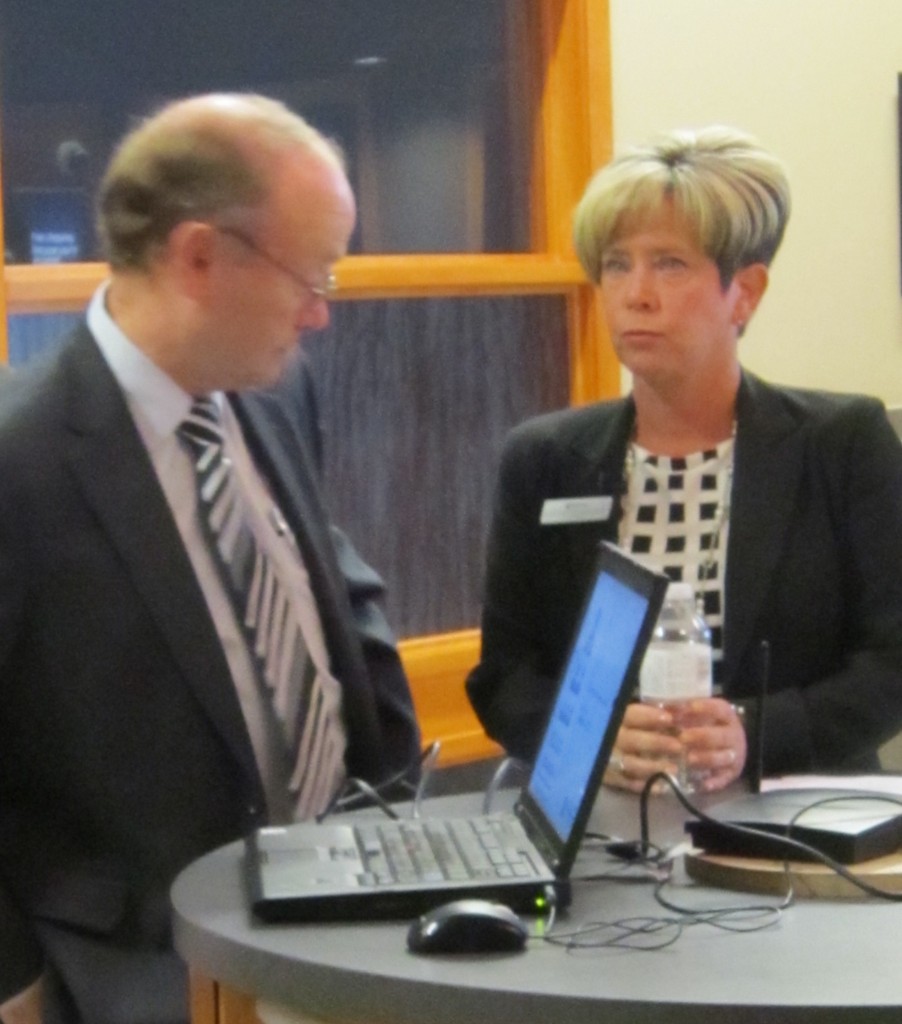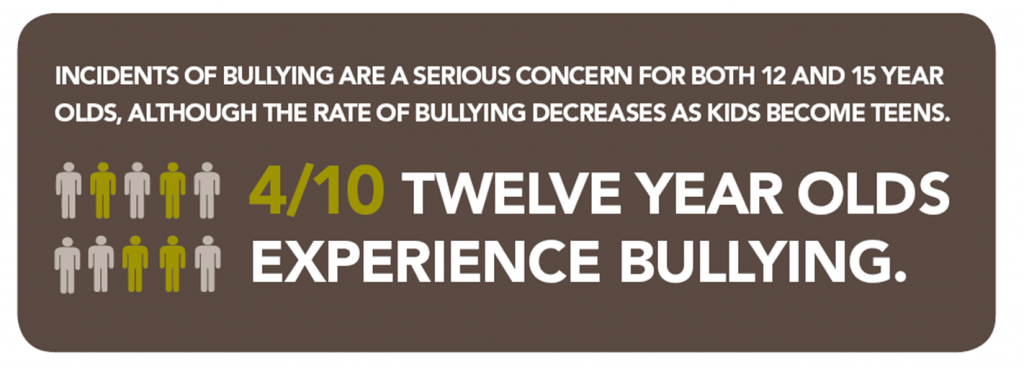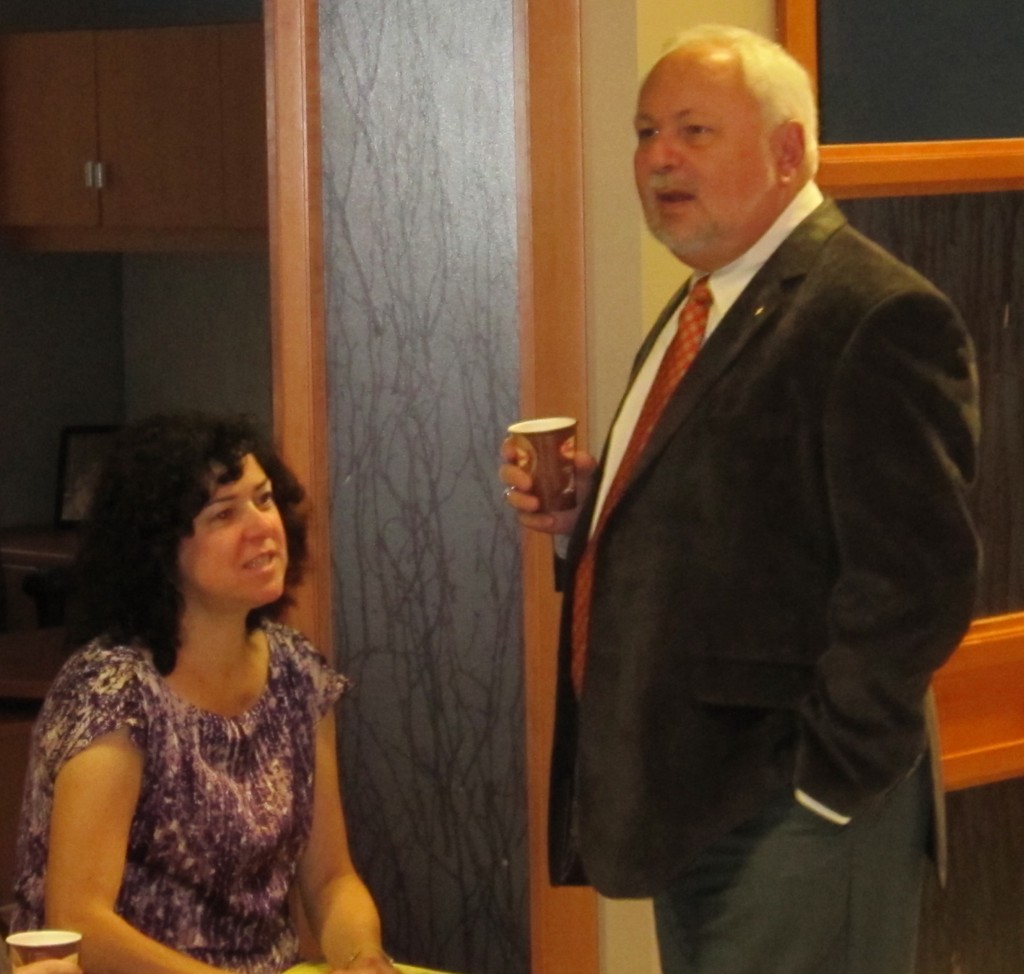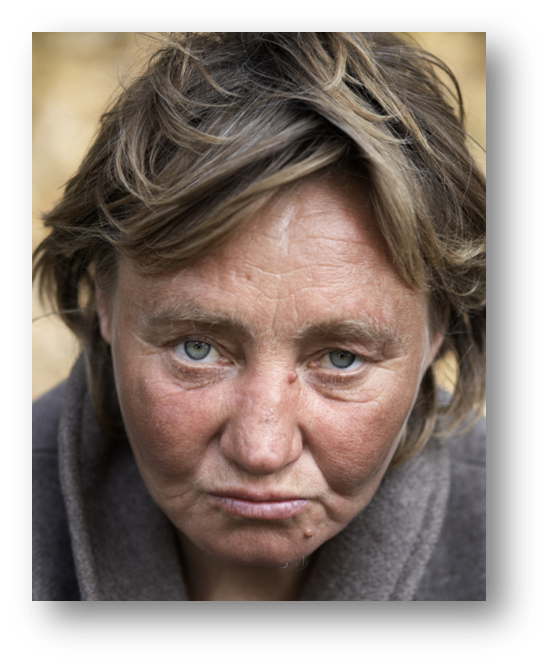BURLINGTON, ON October 3, 2012 A robust crowd gathered early in the morning at the First Credit Union branch to be taken through some “vital signs” about our city – it was not a pretty picture.
The research report, launched by the Burlington Community Foundation, measures the city across ten areas of focus, including health and wellness, environment, youth, and newcomers.

Burlington Community Foundation Tim Dobbie confers with Executive Director Colleen Mulholland about the research report with some stunning data that was made public on Tuesday.
“As a public foundation created by and for the people of Burlington, we help people, corporations and agencies accomplish their charitable goals and address our city’s most pressing needs,” said Colleen Mulholland, Executive Director of Burlington Community Foundation. “To accomplish our mission, we first need to deeply understand the community: our strengths as well as areas of need. This is why we have created our first-ever Vital Signs report, a community check-up that evaluates Burlington as a place to live, work, learn and grow by identifying trends that are critical to our quality of life.”
Burlington is a prosperous and affluent community where its individual, household and family median income is 20% higher than Ontario as a whole. This means it is sometimes harder to see the gaps that exist between rich and poor and the rise in mental health issues among youth. .
We are growing, but not at the rate we have grown in the past and in a direction that brings a lot of problems with it. More than 80,000 of the 174,000 people in Burlington are over 45 years of age and 1 in 5 of us come from some other country.

To fully appreciate just how wealthy we are as a city – look at that field in the middle of the stadium. Burlington’s parks equal 3,303 of those football fields.
Burlington has 1463 hectares of parkland – which is the equivalent of 3,303 football fields. That is a lot of parkland.
In a telephone survey to 300 people done by an outside research firm, more than 91% of the people called in Burlington said they donate money to others who are less fortunate.
More than 33% of the people in Burlington volunteer some of their time to helping others make the city a better, nicer place to live.
That’s the plus side – we are, on paper at least, a caring, giving community.
More than 42% of the people in Burlington earn more than $100,000 a year.
The value of the average home in Burlington is $466,000.
We are a rich community as well but we aren’t all rich.
The bad news is very painful. The vacancy rate for apartments is 1.3% which means the market is very tight and that drives up prices. Nice for the landlords but very, very hard for those living below the poverty line – and Burlington has a lot of people living below that poverty line.
The researchers tell us that within a decade we will see 24% of the population living below the poverty line.
Day care in Burlington costs $60 a day. It isn’t possible for low income people to afford day care at that price,which means they don’t work and require social assistance.

We know who does the bullying and we know for the most part where it is being done. Why aren’t we able to bring an almost immediate halt to this kind of behavior. Is the problem with the children who do the bullying or with the parents of those children. That wasn’t a polite question.
31% of newcomers live in poverty – given that 1 in 5 of us were not born here – that is not a nice number.
24% of the minorities live in poverty.
24% of those who are unattached – a polite word for single mothers, live in poverty. That poverty just grinds these women down and their children suffer.
63% of the people using food banks have been doing so for more than three years. Many thought food banks were a top gap measure. For far too many their trip to the food bank is your trip to the supermarket.
What does poverty look like? Living on $20,778 a year with one in three living in extreme poverty – getting buy on less than $10,389 a year.
In her remarks Colleen Mulholland told of a woman who said she has to steal to care for her family. Why is this happening?
31% of newcomers in Burlington live under the poverty line and tend to earn 50 cents for every dollar other people earn.
Our social problems are not limited to the newcomers. Our youth are suffering from problems they see as staggering. Four out of every 12 young people between the ages of 12 and 15 experience bullying. We know who is doing the bullying – why have we not managed to have it stopped?
Between 10% and 15% of the teenagers have thought of harming themselves.
Between 19% and 27% of teenagers feel they have too many problems.
Between 6% and 11% of teens have thought of committing suicide.
This is a part of the rosy picture we paint of the city we call the nicest place to live in Canada.
When the data was delivered to a room of more than 60 people, BCF chair Tim Dobbie, with a dazed look on his face said “Wow”! It was not a happy wow. He followed that up with a “so what do we do now?”
And indeed that is the question – what do we do now?
Why do we have these problems? Is it all the result in an unequal distribution of the wealth we have? Is it because parents are too busy to do their job of raising their children? Are the schools failing us? Is this happening because we are no longer much of a faith based society?

Len Lifchus, CEO of the Burlington/Hamilton United Way, the organization that raises funds which are delivered to agencies that deliver support services, listens to data he is all too familiar with.
These aren’t polite questions – but when a parent is called to the hospital to talk to the emergency staff about their child having harmed themselves or worse, and this is happening now; when the police knock at your door to tell you that your child has committed suicide, being polite just doesn’t matter anymore.
This report comes out as we get into the 2012 United Way campaign where we need to raise $2.1 million to take care of those who live under that $20,778 poverty line and especially for those that have to try and get by on $10,389.
Do we see the link between the drug use and the social problems? Our Burlington covers the police stories and note that the police are kept very busy tracking down the drug dealers. Having been offered a “joint” as I was coming out of the library a number of months ago I can attest to the size of the problem – the kid was less than 20, taking a break and inhaling that funny smelling cigarette. We all recognize the smell – do we recognize the problem?
It was a tough report that we had to hear and the BCF people deserve full credit for seeing the need and the courage to put the facts before us. Hopefully we will have the courage and the concern to do something about those facts.
Vital Signs is a community check-up conducted by community foundations across Canada that measures the vitality of our communities and identifies significant trends in a range of areas critical to quality of life. The check up is coordinated nationally by Community Foundations of Canada.
The Burlington Community Foundation was established in 1999 by a passionate group of local volunteers and philanthropists to improve the quality of life in Burlington. Several of the city’s former Mayors were instrumental in getting the organization off the ground.
The initial funding came from a Mayor’s Gala sponsored by Rob MacIsaac; the first meeting of the Foundation was chaired by former Mayor Walter Mulkewich.
The Foundation helps people create funds and support meaningful local causes. The Foundation’s experts understand the community and help donors respond to vital needs by providing grants to charities.
The Masquerade Ball, the Foundation’s annual fund raising event tries to sell 600 tickets to the event. They have a lot of fun and the expensive tickets raise the money for the Foundation to operate.





















